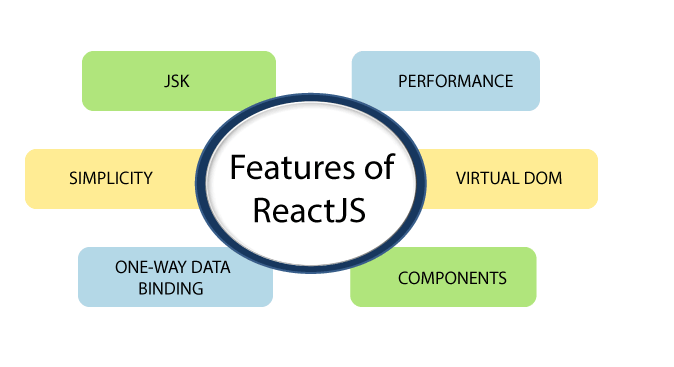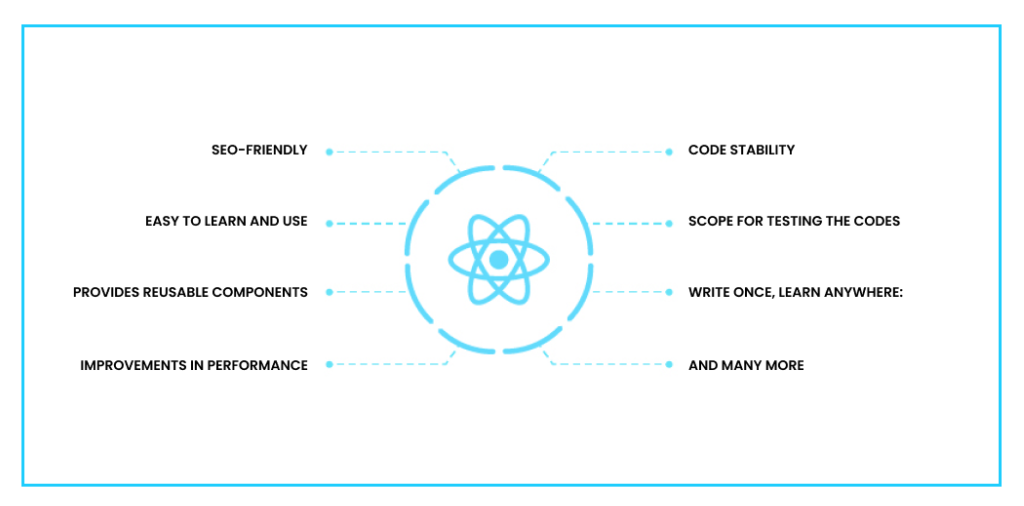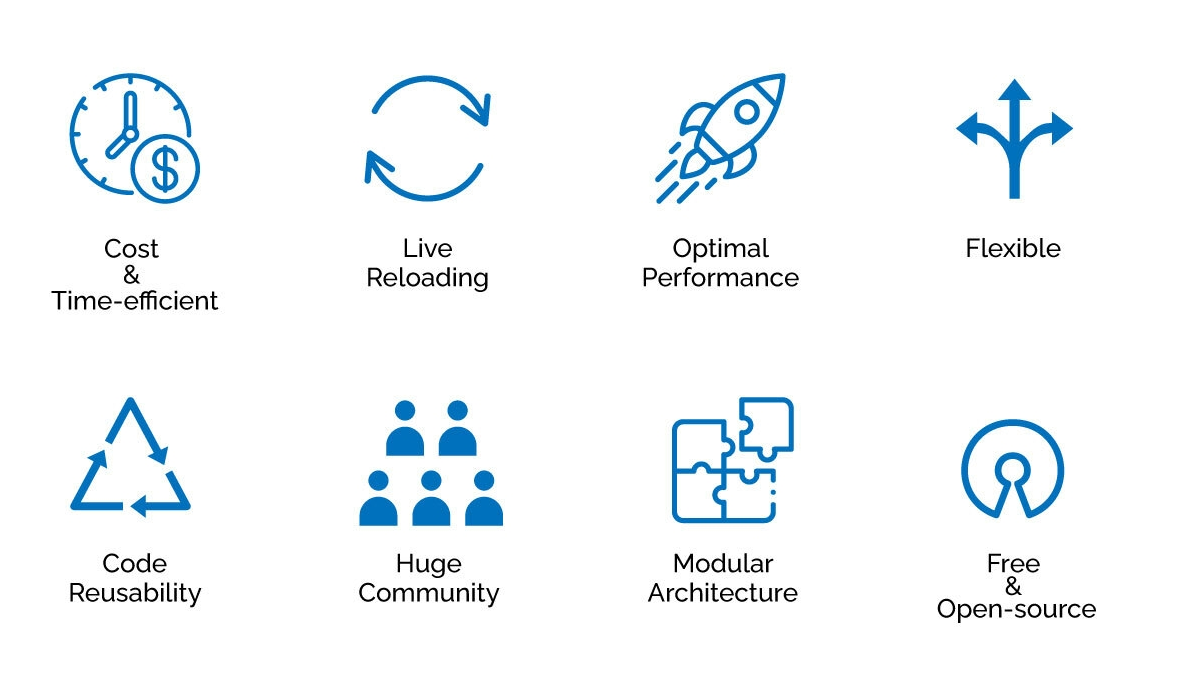These Facebook native technologies offer unmatched power for building mobile apps and websites. It comes down to their function and purpose that distinguishes them from each other.
Almost every website, no matter where they are from, demonstrates the differences between React Native and ReactJS. Most popular websites and mobile applications are built on these two powerful technologies. In app development, comparing ReactJS with React Native is a common topic of discussion.
The React vs. React Native debate can be confusing even to seasoned developers. Before this news blog overwhelms you with its information on the notable difference between react and react native, let’s take time and read everything carefully to understand each aspect.
Table of Contents
What Is ReactJS?

User interfaces are made using the ReactJS JavaScript library. It is used by Facebook as well as a plethora of independent companies and designers.
Reusable components can be used to create web and mobile applications with React, reducing development time and keeping code tidy. It can be used to create reusable UI components for various apps and be predominantly utilized for single-page applications.
What Are the Incredible Features of ReactJS?

ReactJS offers several features that make it a popular choice for building user interfaces, including:
1. Components:
Using reusable components, react enables developers to create online and mobile applications. Large-scale applications may be built and maintained with ease thanks to the ease with which these components can be reused across various sections of an application.
2. Virtual DOM:
A virtual DOM, or lightweight in-memory replica of the real DOM, is used by React. It makes it possible for React to streamline updates and reduce the number of DOM changes, improving performance.
3. JSX:
React uses JSX, a JavaScript grammar extension that enables programmers to build HTML-like elements in JavaScript. As a result, building and comprehending a React application’s structure may be simpler.
4. Server-Side Rendering:
React enables server-side rendering, enhancing an application’s functionality and SEO.
5. One-Way Data Flow:
Data flows in one direction only throughout Reacts applications, hence its one-way data flow. The state of an application can be more easily understood and managed this way.
What Are the Benefits of ReactJS?

The JavaScript library ReactJS is used to build interface design. Some benefits of building with ReactJS include the following:
1. Popularity:
With React, thanks to its widespread use and large developer community, you can find resources and support whenever you need them.
2. Virtual DOM:
Virtual DOMs are used in React, which minimizes direct manipulation of the actual DOM and optimizes updates and performance.
3. Unidirectional Data Flow:
Due to Reacts enforcement of a unidirectional data flow, it is simpler to comprehend and control the state of an application.
4. Strong Developer Community:
It is simple to get materials and support for developing and troubleshooting applications using React because it is widely used and has a vibrant developer community.
5. Server-Side Rendering:
React supports server-side rendering, enhancing an application’s performance and making it simpler for search engines to crawl.
6. Popular choice:
Many well-known businesses, like Facebook, Netflix, Airbnb, and many others, employ React when creating web applications.
What is React Native?
Developers can use JavaScript and React to construct mobile apps with the help of Facebook’s React Native framework.
Employing the same codebase for both iOS and Android platforms, React Native enables developers to create mobile apps with a native appearance and feel.
It does this by using the same design principles as React. As a result, mobile app developers may create apps more quickly, with less expense, and with a more consistent user experience across all platforms.
What Are the Magnificent Features of React Native?

React Native is a mobile app development framework that allows developers to build native mobile apps using JavaScript and React. Some key features of react native vs react include:
1. Cross-Platform Compatibility:
With React Native, programmers can create code that works on iOS and Android devices.
2. Reusable Components:
Component-based architecture, which Reacts Native uses, enables developers to reuse components more quickly.
3. Hot Reloading:
Hot reloading is a feature of React Native that enables developers to view changes they make to the code immediately without having to rebuild the application completely.
4. Performance:
Due to the usage of native components rather than web views, React Native apps are quicker than hybrid apps.
5. Large Community:
The huge and vibrant React Native community makes it simple for developers to get materials and support for their initiatives.
What Are the Benefits of React Native?

There are several benefits to building mobile applications with React Native:
1. Open-Source:
Given that React Native is open-source, developers can access the source code and modify the framework as necessary.
2. Performance:
In contrast to hybrid mobile development frameworks, React Native makes use of native components, which give a more native feel and better performance.
3. Large Community:
The developer community for React Native is sizable and vibrant, offering a plethora of information and assistance for creating mobile applications.
4. Live Updates:
It can save a lot of time for developers to use React Native, which enables them to publish live updates directly to their apps.
5. Cost-Effective:
React Native enables developers to create apps for several platforms using a single codebase, which reduces development time and costs.
What Are the Differences Between React and React Native?
The most awaited moment has come when you can read all the major differences between react js and react native, which will help you know when to choose to react js or react native for a specific project.
- React Native is a JavaScript framework for creating mobile apps for iOS and Android, whereas ReactJS is a JavaScript library for creating web applications.
- ReactJS employs a virtual DOM to speed up online apps, but React Native speeds things up using the platform’s native components.
- While React Native uses JavaScript to create components, ReactJS employs JSX, a grammar extension for JavaScript.
- React Native is used to create mobile apps, while ReactJS is mostly used to create web applications.
- While React Native is used for creating single-page mobile applications, ReactJS can create multi-page online applications.
- ReactJS and React Native share the same core principles and concepts but have different APIs and require different knowledge and tools to build and deploy apps.
So, these were the differences between react and react native development, which you consider before choosing it for web development.























